Film Title: David Bowie – Ricochet
Year of Release: 1984
Directed by Gerry Troyna
Synopsis:
A film diary of musician David Bowie’s “Serious Moonlight” concert tour through Hong Kong, Thailand and Singapore. Featuring classic performances both on and off stage, Bowie interacts with the local people and culture as he travels across Asia with his band.
In Singapore, he takes time off rehearsals, interviews and preparations for the concert to visit places of interest in Singapore, such as Sungei Road, Little India, and Far East Plaza. He talks to taxi drivers and chinese opera performers, and attempts to weave together an ambiguous narrative of his exploits through “other-worldly” landscapes. Features the 1980s street scenes of Singapore.
The Film Locations:
1. Sri Mariamman Temple, South Bridge Road.
 Sri Mariamman Temple, Singapore oldest Hindu Temple, founded in 1827. Located in the heart of Chinatown.
Sri Mariamman Temple, Singapore oldest Hindu Temple, founded in 1827. Located in the heart of Chinatown.
…
2. Masjid Abdul Gafoor, Dunlop Street. Little India.
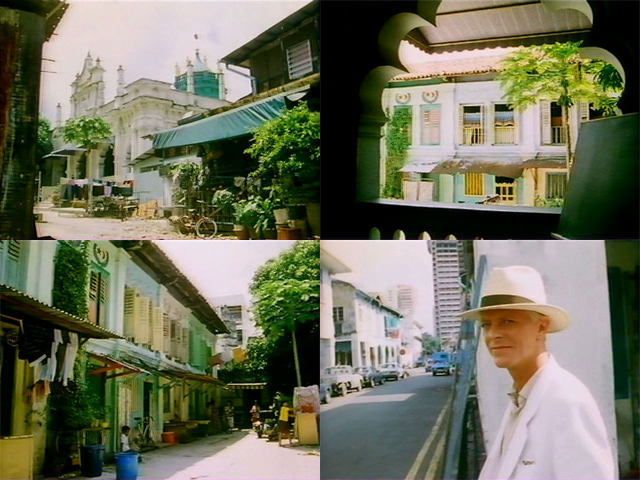
David Bowie stumbles into places of religious interest. Here, he comes across the Abdul Gafoor Mosque, an Indian Muslim Mosque, in Kampong Kapor, Little India. The mosque stands opposite a row of shophouses, used as residences in the 1980s, now used for Quran classes and communal activities.
Lower right: Bowie walks to the junction of Dunlop Street and Perak Road. The tall building in the distance is the Rowell Court HDB Housing Complex.
..

The filming locations in “Ricochet” as they are today (December 2012). Masjid Abdul Gafoor, Dunlop Street, Perak Road and Rowell Court HDB Flats.
…
3. Thian Hock Keng Temple 天福宫, Telok Ayer Street.

Thian Hock Temple, or the Temple of Heavenly Happiness, the oldest Hokkien temple in Singapore, founded in the 1820s. The main temple is dedicated to Ma Zu 妈祖, the mother goddess of the sea and protector of all seamen.
…
4. Sakya Muni Buddha Gaya Temple, Race Course Road. Farrer Park.

Sakya Muni Buddha Gaya Temple, founded in 1927 by Thai monk Vutthisara. It is most renown for the 15-meter-tall statue of a seated Buddha. Bowie seems to stand in awe of the towering religious icon, and tries his hand at the ‘Wheel of Fortune’.
..
I paid a visit to the temple in December 2012.
…

David Bowie boards a yellow-top taxi. (Yellow-top taxis were a collective group of individually owned taxis in Singapore, common in the 1960-90s. They have a yellow top and black body, hence their name. Yellow-top taxis are no longer in operation now. Taxi drivers are now coerced to rent their taxis from taxi companies or public transport conglomerates.)
Bowie has a casual discussion with the taxi driver about the chewing gum ban and drug offenses in Singapore.
In the film, Bowie’s chat with the taxi driver is immediately followed by a montage of scenes of our beloved city — skyscrapers, urban redevelopment, social engineering banners, a portrait of a politician, a school military band — accompanied by the march of the Singapore national anthem, “Majulah Singapura”.
Lower right film-still: Shophouses along Beach Road being demolished. Shaw Towers in the background.
Watch an excerpt from the film here, which contains sequences of the taxi-driver-Bowie chat and the “Majulah Singapura” montage.
…
5. An Unknown Building, and Shaw House at the junction of Orchard Road and Scotts Road.
(Updated on 1 Feb 2013: The “unknown” building was the Tropicana Theatre Restaurant along Scotts Road, where Pacific Plaza is today.)

Bowie’s taxi passes several buildings, two of which have facades reflective of the 1970s-80s architectural style in Singapore. On the left film-still is a building which I am not yet able to identify, but it has a distinctive facade. On the right film-still is the Shaw House along Orchard Road, in 1983. In the 1990s, this will be torn down and replaced with two new office buildings owned by the Shaw brothers and a Shaw cineplex-cum-shopping-mall.
(Updated on 1 Feb 2013): The building on the left film-still has been identified as the Tropicana Theatre Restaurant along Scotts Road, courtesy of A.Lim who left a comment below. It was Singapore’s first entertainment complex to feature a cabaret theatre, restaurants and nightclubs. Opened in 1968 with the support of the Singapore Tourist Promotion Board, it was best known for introducing topless revues to Singapore. Jazz greats such as Duke Ellington and Count Basie had performed there.
The building was also designed by architects from Kee Yeap & Associates. It later closed in 1989 and a shopping centre, Pacific Plaza (still standing today), was built in its place.
I looked through the Singapore Archives’ online database PICAS and found photos of the interiors of the theatre and nightclubs in Tropicana.

PICAS’ description: Owner of Tropicana Theatre at Scotts Road, S C Shaw (Shaw Sung Ching) overlooking The Orchid Lantern Room as the nightclub closed after 21 years of operation.
…
6. Ming Court Hotel Lobby and Emperor Suite
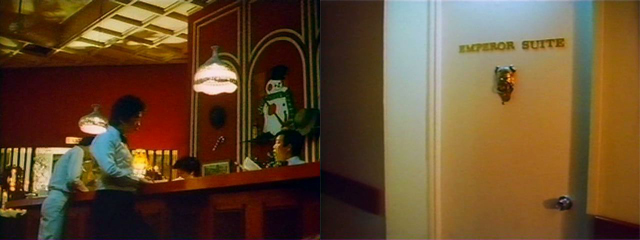
Bowie returns to his place of accommodation at the Ming Court Hotel. He had checked into the Emperor Suite. The Ming Court Hotel, located along Tanglin Road, was renamed Orchard Parade Hotel in 1991.
…
7. Far East Plaza, Scotts Road.

Bowie leaves the comfort of his hotel suite and wanders into the night. He seems to take on another persona. The film departs from its documentary inclinations and the mood, colours, and background music henceforth evokes a quasi-sci-fi-apocalyptic narrative, with Bowie as a traveller in an alien landscape.
Here, he walks past the bus-stop in front of Far East Plaza (then a rather new shopping centre which had opened in 1982). The bus-stop has pyramidal roofs and spherical lights lining the edge of the roof. A “Trans-Island” bus drives into the bus-stop. Bowie walks non-chalantly towards the neon-blue-strip-lit escalators — almost like a portal to another place and time.
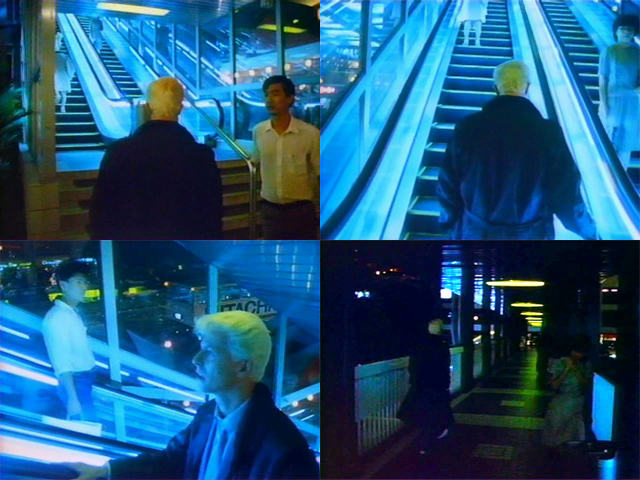
“Bowie commissioned (Gerry Troyna the director) to make the official document of what was openly referred to as ‘The Bungle in the Jungle.’ This wouldn’t be a conventional tour-film, Troyna hired screenwriter, Martin Stellman, to draft a rough script…”
– sporeana.blogspot.sg

“Troyna says that the script outlined the “points we wanted to make about each country”, Singapore was intended to reflect “alienation and submission to the state”, but of course there would be a great deal of improvisation. The director walked around Orchard Road and discovered Far East Plaza, Singapore’s newest and (at that time) largest, shopping mall, opened only a few months earlier. It was a suitably “alienating” place. Bowie agreed.”
– sporeana.blogspot.sg
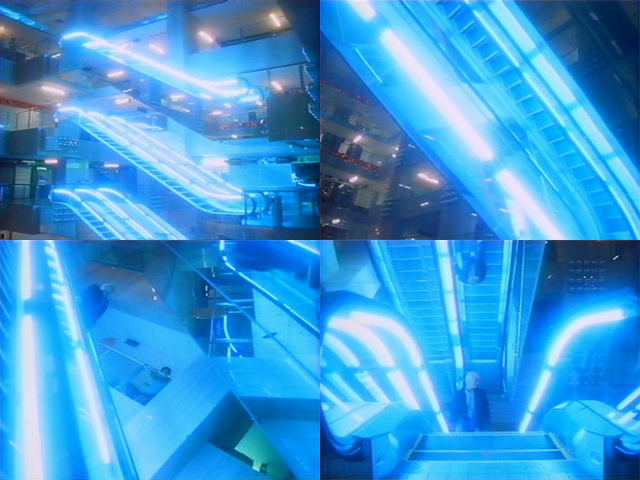
“(David Bowie) walks through the night in a black trenchcoat. Heads down Scotts Road and up an escalator to an overhead bridge drenched in blue neon, his yellow hair the only sign of life. The eerie-sinister soundtrack is ‘Sense of Doubt’, a Bowie/(Brian) Eno collaboration (from the ‘Heroes’ album). Here it’s used to lend atmosphere to the sterile sci-fi weirdness of ‘The Biggest Tourist Shopping Centre in South-East Asia’. After his escalator odyssey and a surreal scolding from a diminutive security guard, Bowie sits, looking pensively unimpressed, beneath the glittery kitsch of the musical fountain and a row of fake, plastic Christmas trees.
– sporeana.blogspot.sg
…
8. Raffles Hotel, and Raffles City under construction.
The next morning, Bowie boards another taxi and makes a rather pointed request to driver: “Can we go somewhere, like, where there are no skyscrapers?” The taxi driver offers him two options — “the old building or the new building”. Bowie chooses the former and is driven to the Raffles Hotel…
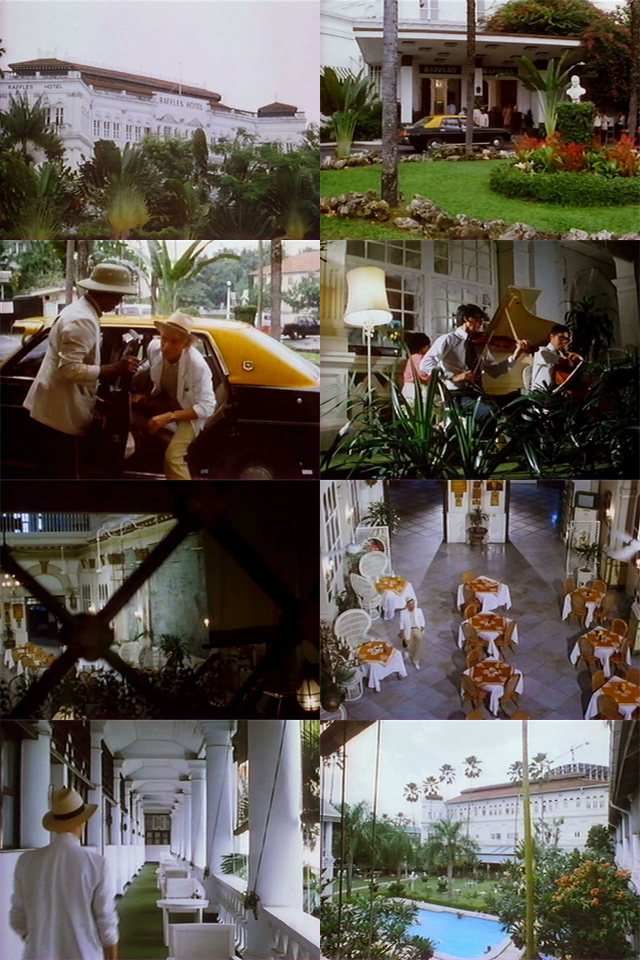
“Then he’s amidst ghosts of a different kind. Inside the faux-colonial splendour of Raffles Hotel, Bowie seems as equally apprehensive as he did back in the mall. He’s swapped cold futurism for tropical nostalgia and found both equally wanting.”
– sporeana.blogspot.sg
Unfortunately, even within the snug confines of the Raffles Hotel verandas, Bowie is troubled by the relentless noises of construction next door – the Raffles City shopping mall and hotel under construction (in 1983).
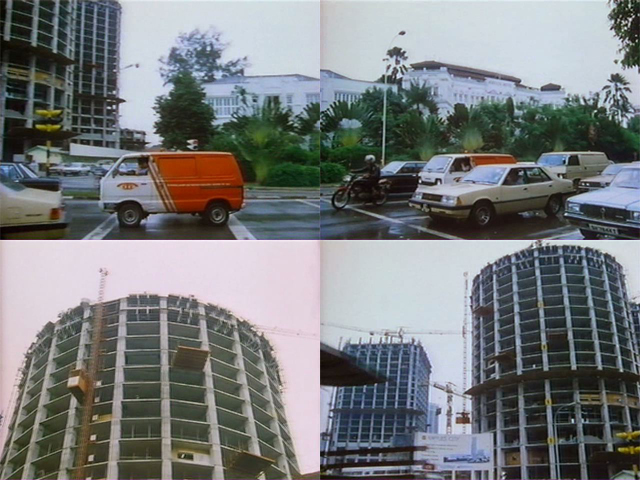
Bowie had made a critical remark earlier in the film: “They are tearing a lot of buildings down, eh?” The Raffles Institution, the first school in Singapore, was demolished to make way for the construction of Raffles City, which includes a massive multi-storey shopping mall and a one-time world’s tallest hotel. Designed by world renown architect I.M Pei and completed in 1986. The old tends to make way for the new in Singapore; the global preferred to the vernacular.
…
9. Former National Stadium, Kallang (demolished)
They tore this one down too. It was where Bowie held his first concert in Singapore. In its place will be a new Singapore Sports Hub, inclusive of a new stadium that features a retractable roof, due to open in 2014. They want a spanking new and glitzy, world-class stadium to boast of. No room for nostalgia.

David Bowie wrote of his landmark concert performance in the former Singapore National Stadium:
“I rip through a welcome and an introduction to the band in Chinese. It is received with dutiful sympathy by the crowd as my pronunciation is so dreadful that not one word is understood. The audience end of the ramp is so far away from the band that I am singing half a beat behind them. I look back and see a tiny, jumping Carlos Alomar leading a badly lit rock’n’roll group. I peer out and see paramilitary cops at the ratio of about one to two with the first row. They finger their billy clubs, their hands on their guns.
My jacket style is designer Tokyo — skyscrapers and diamante searchlights. There is so much lacquer in my hair that a hurricane couldn’t move it. My shirt is held into my pants by elastic thongs round my legs. I have two pairs of socks on because of oversized shoes. I am imploring the crowd, “put on your red shoes” … there is a scream of recognition —15,000 strong. A tiger-print-clad girl is slapped back over the security boundary by a ferocious swing of a billy club.
In a city where you can be arrested for chewing gum, a demand to put on red shoes is deemed unhealthy.”
(Source: http://thisrecording.com/today/tag/david-bowie)
Is Bowie being overly critical of the billy-club-toting boys?
…
10. Sungei Road, Jalan Besar, and Rochor Centre HDB Complex.
Troyna the film director and Bowie contrived to juxtapose footage of his rock concert with those of a stage performance of the vernacular kind — Chinese street opera, otherwise known as “Wayang”. They found one opera troupe operating in Jalan Besar, with the outdoor stage built at the junction of Kelantan Road and Sungei Road, next to the Rochor River.
..
Aerial shots of the city (recorded from the top floor of HDB Block 30, Kelantan Road) offer themselves as establishing shots for sequences involving the day-to-day activities of the street opera troupe members.

Film-still from “Ricochet”. Shot from HDB Block 30, Kelantan Road. Sim Lim Tower on the extreme right of the film-still. The Rochor Canal extends from the lower left corner. The Rochor Centre HDB Complex is in the centre (it will soon be demolished to make way for a new expressway). Bowie’s “tearing buildings down” remark still ring true after thirty years; the perpetual drive to renew, upgrade, redevelop, forget and blank-out.
The shophouses in the lower right corner were first to go twenty years back; torn down, and the site left vacant (except for an open-air laissez faire flea market) until the recent development of an underground MRT station on the site.

A similar view from the top floor of Block 30, shot in December 2012. The buildings are more colourful now, but that doesn’t deflect the gloom of their eventual demise. Sim Lim Tower, being old and relatively unpopular, may have to make way for a new shopping-cum-entertainment complex in the future?
..

Film-stills from “Ricochet”. Close-ups of the facades of the Rochor Centre HDB housing flats. Bowie would have been critical of the design – cold, hard, uniform, regular, ultra-functional and boring. Nonetheless, these HDB blocks are representative of an era of rapid mass housing developments and experimentations with types — the housing-cum-retail shops-cum-communal centres all-in-one complex.
Apologies, no room for nostalgia. Make way for more roads to ease the traffic jams.

Close-up shots of the now-colourful facades of the Rochor Centre HDB flats. Also shot from Block 30, Kelantan Road. December 2012. A fresh coat of makeup before the funeral.
..
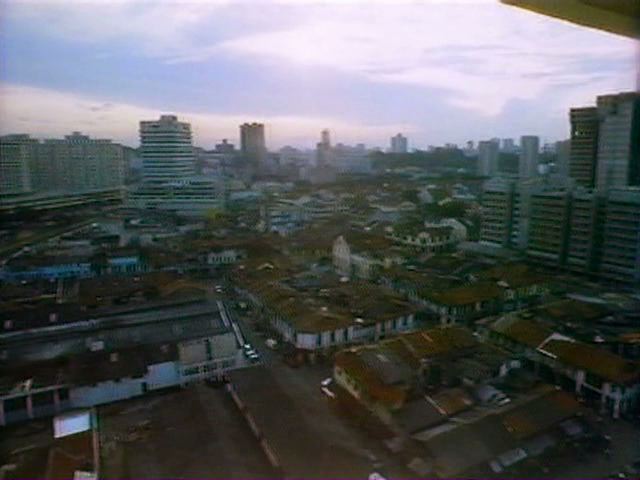
Film-still from “Ricochet”. Dusk. The vicinity of Sungei Road and Jalan Besar. Shophouses line the minor streets in the foreground of the shot — Pitt Street, Larut Road, Kelantan Road and Weld Road. There was even an ice factory along Sungei Road — Singapore Ice Works (established in 1958). All the shophouses to the left of Jalan Besar in this shot were demolished in the 1990s.
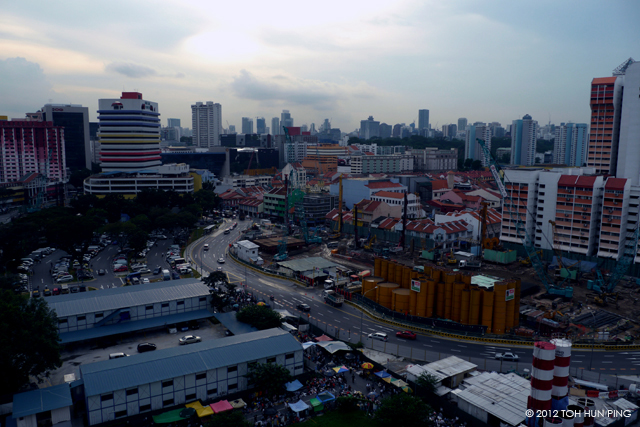
A view similar to the previous film-still from “Ricochet”. Vehicles travelling along Jalan Besar make a detour around the site of the construction for a new underground MRT station. Rowell Court HDB flats on the extreme right is still standing.
The open-air flea market in the foreground survives from the days when the shophouses were still standing, through its resurgence in the early 2000s when it took up all the minor streets of the Sungei Road vicinity and became a popular haunt for second-hand goods shoppers and tourists alike.
Today, the flea market has shrunk in size and merely took up three shortened minor streets, remainders from the spaces occupied by the diverted Jalan Besar, and the MRT station construction sites and offices.
..

A current map (December 2012) of the Sungei Road vicinity. Jalan Besar makes a diversion due to the construction of a new underground MRT station.
..

Film-still from “Ricochet”. Shophouses lining Larut Road and Pitt Street. A spate of fire destroyed some of the shophouses in 1991. The rest were torn down soon after as they were deemed to be potential fire hazards. It is suggested in the film that the street opera troupe members featured lived in these shophouses, close to the outdoor Wayang stage set up along Sungei Road, next to the Rochor Canal.

A view similar to the previous film-still from “Ricochet”. Larut Road is occupied by the remnant flea market in the lower left corner. Pitt Street is shortened due to the diversion of Jalan Besar.
..

Film-stills from “Ricochet”. The living spaces of the street opera troupe members. It is suggested in the film that they live in the shophouses in the vicinity of Sungei Road.
..

In the evening, the street opera troupe members (some with their babies in tow) take a stroll down Sungei Road from their homes to the “Wayang” stage and prepare themselves for the night performance.
Sim Lim Tower and Rochor Centre are in the background.
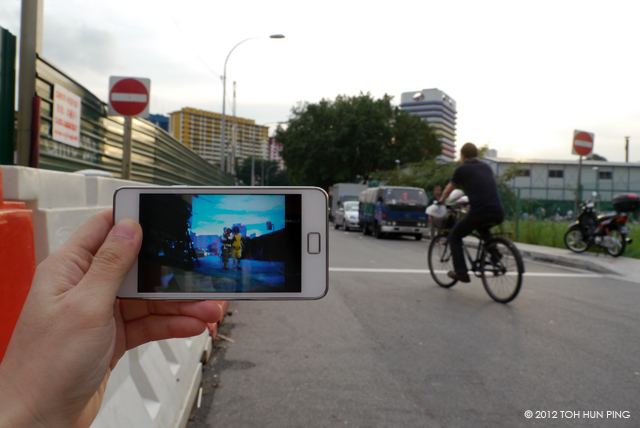
The state of Sungei Road in December 2012. A view from an angle similar to the previous film-still from “Ricochet”.
..

Film-still from “Ricochet”. The open-air “Wayang” stage in front of HDB Block 30, Kelantan Road. Spectators stream in for the next night performance.

A view from an angle similar to the previous film-still from “Ricochet”. December 2012. Rochor canal is currently fenced up for redevelopment.
..
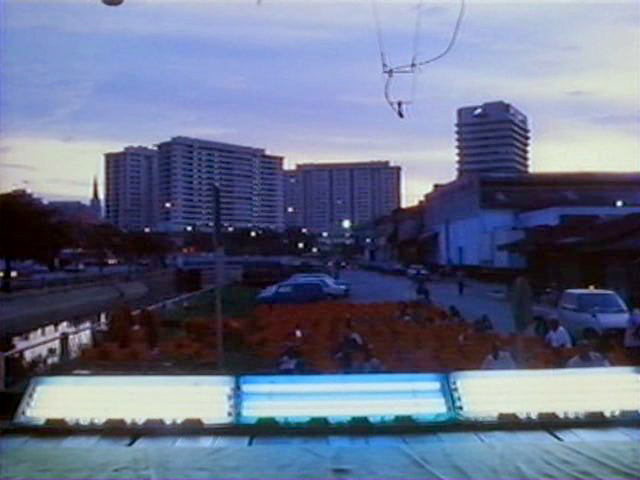
Film-still from “Ricochet”. A view from the opera stage. Rochor Canal is on the left of the film-still. Sungei Road in the middle. The Singapore Ice Works on the right. Sim Lim Tower and Rochor Centre in the background. This view has undergone changes (the Ice Works no longer exist) and will continue to change (Rochor Centre will be demolished by year 2016).

Film-still from “Ricochet”. Will there still be room for open-air Chinese street opera stages in the future? Truth be told, I don’t even watch chinese opera. Can’t understand what is sung, but keen to understand. I will get there.
..
More photos of the Sungei Road vicinity, recorded in December 2012:
…
“Bowie performing (the song) ‘Heroes’ is intercut with scenes from the Chinese wayang, so much so that the song eventually seems be placed into the mouths of the singers. Before he turns his back on the audience in the stadium Bowie grins, almost laughing, suddenly, finally happy. Then for a moment, Bowie’s in the audience at the opera, surrounded by aunties and uncles, looking extraordinarily handsome, and Heroes has become their song, Singapore’s song. Its final chords played out over a beautiful close-up of an opera performer. An equilibrium is found between music and image. A symbolic moment for a weary showman; performer gives way to other performers and becomes the audience, a final reversal. It’s ambiguous, but it’s also hopeful. And that’s how David Bowie and Ricochet leave Singapore.”
– sporeana.blogspot.sg
Watch Bowie’s “Heroes” juxtaposed with Chinese Street Opera here.
…..




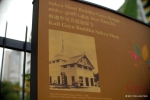









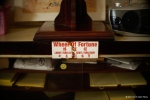




















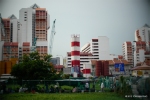

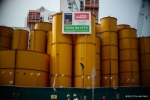
Hi there – Ben Slater here – creator of sporeana.blogspot – just found your site, very impressive! I have some films you might like to see and vice versa. Drop me a line – ben@gonetopersia.com
Fascinating blog! The unknown building on Scotts Road is Tropicana theatre restaurant. Pacific Plaza occupies that space now.
Thanks for your inputs! Somehow I was not able to identify the building even though I have would travelled along Scotts Road in the 1980s (I was a primary school student then…) My strongest memory associated to “that space” would be of the Tower Records in Pacific Plaza. I guess ten percent of my CD collection was purchased there!
A brilliantly researched and documented blog! Well done! You’ve gone to an enormous amount of trouble to photograph in order to make the comparisons.
I purchased this DVD several years ago for the express reason of viewing David Bowie in Singapore. It took me several years to work out that the shopping Centre used is Far East Plaza – even though the escalator and Pedestrian Overhead Bridge (POB) was quite recognisable, and from what I recall still looks much like that today (it did in the late 1990’s anyway).
A couple of comments/queries:
(1) I had no idea that the instrumental (keyboard) played (during Bowie’s ride up the escalator and through Far East Plaza) was actually a song from a previous album (“Sense of Doubt”), The collaboration with Brian Eno is also quite interesting, given Eno is quite well known for working with global rock giants U2 in the 1980s.
(2) Does Far East Plaza still have those 3 “fountains” that cascade down from the ceiling?
(3) Do you think you might – at some stage – attempt a similar comparison for the movie “Saint Jack”? I’m assuming here that you have a copy on DVD.
Hi Malcolm,
Thanks for visiting the blog and for your positive comments! Much appreciated.
Yes, the Far East Plaza escalator and the bridge still look pretty much the same today, though they are a bit rundown since the last renovation many years back.
I wasn’t aware that the soundtrack used in the “shopping centre” scene was “Sense of Doubt” too when I first watched the documentary. Was only familiar with Bowie’s better known songs and albums (eg. Hunky Dory, Ziggy Stardust). Only realised that when I read this blog – http://sporeana.blogspot.sg/2010/10/up-escalator-forever-bowie-in-singapore.html
Nope, the “light fountains” that ran all the way up to the ceiling are not there anymore.

Yep, I do have a copy of “Saint Jack”, and I do intend to compose a blogpost on it in time to come. There are a lot of locations to cover in that one!
Thanks again and do visit the blog again. The recent and coming posts are on “Pretty Polly”, a British but Hollywood-backed film shot mainly in Singapore…
Hey,
Thanks for your response.
One thing I forgot to mention in my initial post, was how amazingly appropriate I find the sinister instrumental – “Sense of Doubt” – is when it is played for that 3 minute sequence. Sinister because Singapore – and more to the point the Singapore government – seems to give that impression over a long period of time, with censorship and, in David Bowie’s case, imposing strict restrictions on his 1983 concert.
Thanks for the current photos of Far East Plaza – it sort of confirms a vague memory I have of visiting it several years ago when passing through Singapore.
I don’t have Pretty Polly on DVD nor video, but vaguely remember watching (at least parts of it) probably on YouTube a few years ago. I read your blog of this movie and it was also well researched. The Singapore from 45 years ago is virtually unrecognisable compared with today – but then that’s really no great surprise.
Saint Jack will certainly be a great documentary piece. I have been fascinated by that movie since first watching it 10 years ago. I was corresponsing with Ben Slater – author of “Kinda Hot” – around the time he was starting out his research for his book, which is written about the film. Working out where the “Prince’s Hotel Garni” was on Orchard Road was one of the first big revelations of filming locations. When you come to comparing locations, I’ll be very interested if you have any more luck than Ben or myself with identifying the specific house/address that was used in the filming of “that” scene at Lorong J Telok Kurau.
i am pretty much certain the telok kurau house was demolished due to road widening. from the film stills i have ascertained the location is at the junction of lorong J telok kurau and still road. as the taxi drives towards the house it passes hotel malacca. you’ll see the window designs match, as do the windows of an apartment near by.
scene of still road by hotel malacca
scene with apartment on still road (apartment to the right)
Hi Paul,
Thanks! You are right. That house in “Saint Jack” was indeed at the junction of Still Road and Lorong J Telok Kurau. Yes, it must have been demolished when Still Road was widened. The Malacca Hotel is the give-away.
I had initially thought that the house was at the junction of Telok Kurau Road and Lorong J Telok Kurau, since there are still a few 2-storey terrace houses of which the architecture is very similar to the ones in “Saint Jack”, right down to the gate design. The single storey pitched-roof building across the road (Lorong J) from that “Saint Jack” house is also strikingly similar to the one in the compounds of the current “Telok Kurau Studios”.
Congratulations Paul for figuring out that out! As I said in my book, that was the one location that there wasn’t a specific address for in the production notes. Now you’ve nailed it. But sadly it’s gone.
Hi Paul,
Thanks for your reply – it has finally solved a decade long mystery for me and several other people who have been trying to work this out. Well done!!
I first watched Saint Jack in around 2003, and have watched it many times since then. I worked in Singapore from 1995-2002, and in 1997 whilst browsing through the Straits Times one day, came across the article describing how the once-off screening of the film would happen at the Singapore International Film Festival. I was so intrigued that an American film was made in Singapore – with several well known actors – using a false script and title, and yet was never shown there for various reasons. Yet despite this incredible censorship that the Singapore government was/is infamous for, they allowed a once-off screening. Unfortunately, the newspaper I was reading was already from the previous week – so I missed the screening. But I was lucky enough to keep the actual article – fortunate because I probably would have forgotten about it years later when I returned to Australia and remembered about it, and finally purchased the DVD, which at that time was easily available on the internet (probably not so in 1997).
I managed to work out where many of the locations were – even before Ben Slater’s Book “Kinda Hot” was written and published. The one location that none of us could ever work out – despite the street sign “Lorong J Telok Kurau” being prominently and deliberately shown in the film scene – was where that infamous brothel was. I’ve been back to Singapore many times in the past decade, and on a couple of occasions have gone out to Lorong J and walked up and down that street, but never conclusively worked out where it was. I had imagined that the house was like the majority in that area which had been renovated beyond recognition.
Like sublime4199, I had always thought that the house was probably around Telok Kurau Road, or between that junction and the park/canal at the eastern end of the street. I had essentially thought the road widths shown in 1978 would be the same as the present, and the film shows a couple of narrow roads (one lane in each direction).
I can always remember Still Road as being 3 lanes in each direction, so had perhaps naively thought that it always was, and never considered that it was one of the roads used. It just goes to show how much Singapore has changed, not just for the better known areas like Orchard Road, but even for a generic main arterial road like Still Road, that it was upgraded from a 1 lane road to a 6 lane dual carriageway.
Like you mentioned, the Malacca Hotel is the major clue. I watched the scene a few times last night (for the first time I watched it on my computer, which actually was a lot clearer), and like you say, the window arrangements (particularly the small ones on the side of the building – which are probably for the bathrooms) and number of storeys prove it straight away. Another thing which proves this is Malacca Hotel in the film; you will notice some large open windows at each storey, in a wall that is perpendicular to Still Road. I would guess that this is an open air staircase. If you compare with google street view (which I’m relying on), you’ll notice that these openings have been blocked up and painted. It’s fairly obvious that this has been done in more recent times, as a contrast in the paint can be seen (and hence the shape of the old openings is still obvious).
I tried comparing the apartment that you mentioned, however in the film the camera swings around too quickly, so even pausing the film it is quite blurred and I couldn’t make any comparisons with what is on google street view.
So, all along, we’ve been searching for a house that does not exist, and was demolished quite some time ago for the widening of Still Road. This also had me intrigued, so I did some searching on the Singapore National Library newspapers archives, and entered “Still Road widening” into the search engine. In 1985, there were several letters to the editor of the Straits Times complaining about the worsening traffic situation along Still Road. The best information is shown in an article dated 24 Sep 1985 – http://newspapers.nl.sg/Digitised/Article.aspx?articleid=straitstimes19850924-1.2.76.2.4&sessionid=9fd779ddd43e425e90508496dfa8e0f8&keyword=Still+Road+widening&search=advanced&fromdate=19850101&todate=19870101&articles=1&advertisements=1&illustrations=1&letters=1&obituaries=1&miscellaneous=1&newspaperTitles=beritaharian%2cdailyadvertiser%2ceasterndaily%2cmalayansatpost%2cmiddayherald%2csingchronicle%2csingdailynews%2csingmonitor%2csingweekherald%2cstraitsadvocate%2cstraitschinherald%2cstraitseurasian%2cstraitsmail%2cstraitsobserver%2cstraitstelegraph%2cstoverland%2cstweekly%2cbiztimes%2cfreepress%2csingfreepressa%2csingfreepressb%2cstraitstimes%2ctoday%2cweeklysun%2cnysp%2cscjp%2clhzb&fuzzysearch=Off&token=widening%2croad%2cstill
It shows a plan of the existing road and the new road, with the properties to be acquired for road widening also shown. From this diagram, it’s apparent that the brothel shown in the house used to be standing on the south eastern corner of Still Road and Lorong J, and that it would have been where the present Still Road southbound carriageway’s 3 lanes are. So, from the date of this article, it looks like the house in the film was demolished in either late 1985 or early 1986.
One thing I noticed from looking at google street view yesterday was that the first house along the southern side of Lorong J is “No. 4”. It seems like No. 2 does not exist. So I’d be fairly certain that the house in the film was No. 2 Lorong J Telok Kurau.
I worked out another couple of things whilst watching the film last night. The first is, around 2/3 of the way through that scene, Jack walks downstairs and talks to Mamy, and then is looking outside through the front security grille sliding door (looking rather concerned about potential triads in the area). At this time, the fence between the brothel and the adjoining property can be seen, as can the driveway gate of the adjoining property. So, either a group of terrace houses or a semi-detached house was demolished.
The other thing is that some buildings can be seen on the other side of Lorong J – directly opposite the brothel. I don’t think this can be the “Orchard School – Singapore Commercial School” building that is presently there, because that would have been to the east of where Jack was looking. The 1985 diagram in The Straits Times shows no property needing to be acquired on the eastern side of Still Road between Joo Chiat Place and Lorong J – it appears to be an empty field. So whatever buildings Jack was looking at, were probably demolished between 1978 and 1985.
Hello Malcolm, I’m glad to have made some contribution. I’m so late into the game 🙂 I’ll catch up! Thats a good find from the national archives. i too tried searching for information on the widening.. but somehow i missed it.. I didn’t realise that the widening was so recent. Then again I didn’t grow up in the East so I wasn’t too cogent of the changes happening. You’re probably right on the demolishing of the house opposite the brothel. It sounds typical of Singapore to creep up on these things 🙂
Hello Ben, It’s been ages. Trust you have been keeping well. If you’re on Facebook, hit me with a message or invite (following the link of the photos that I posted up). I am keen on a copy of Kinda Hot
Cheers – Paul
Hi Paul,
I forgot to ask – how is it that you determined it was Malacca Hotel in the background? ie what prompted you to consider that building and Still Road as an option?
I’m now trying to work out ways of obtaining some (or one) photographs of the house – if they exist. I would bet that there would be some in existence.
There’s two options that I know of. The first is this website: http://pictures.nl.sg/Details/a39858d0-25bf-40f3-aab9-1b0ae25ee026
It contains a lot of photos around the Telok Kurau area taken in the early 1980s, including several along Lorong J, although none near No. 2. The hyperlink shows Still Road at the Lorong M junction, which is probably as good an indicator as any of what Still Road looked like in 1978.
I think the other option would be to contact LTA. LTA has been the government authority responsible for undertaking these types of road widening projects since they formed in 1995. The project would have been undertaken by PWD, which merged with MRTC to form the LTA. Prior to undertaking the project, the PWD would have had pre-condition surveys done of adjoing properties. There would also be some information on the properties earmarked for demolition (hopefully some photos). How readily available this information is (given it would be from 28 years ago), and whether they would be willing to provide it, is another matter.
Hi Malcolm,
I drove around Lorong J a bit and like you, couldn’t quite match up the house to anything that was there. There were however two strong contenders. One is a completely renovated white house which is 81 Lorong J (junction of J and Telok Kurau Road) but that was just too far away from the main road of Telok Kurau. The other contender was the neighbour of house 78A. (can’t see the number on Google Maps) That one had a similar structure.. and it looked as old and similar to the brothel but its original metal grille was of similar period but different design, so I ascertained that it was not the house. If the house were to have been renovated, it would have changed in the 80’s and taken on a more 80’s design.
After review the footage on the computer, the windows of Hotel Malacca haunted me… it seemed so familiar and it was confirmed the same when I googled images of Hotel Malacca. I noticed that amongst the changes of Hotel Malacca, the pipes were originally on the exterior of the building and have since been moved (internally perhaps). It was the windows that was the turning point. In fact second to the features of the brothel house, I used the panning shot to gather evidence in my deduction 🙂
BTW an old friend, Bob (you’ll see his comments on my facebook post of the movie stills) he still lives in that area and did say that he went to see the shooting. This is what he said:
“I saw the filming as a young boy. These guys chased us away n I chained my bike to the road sign and, I believe they caught that on film. They’d used a “sleazy” terrace house also along still road, juz after Koon seng/lor j junction.”
Perhaps there are more nuggets of information in that post. Why don’t you message him. Tell him Paul Lincoln sent you 🙂
From this photo. you can actually see Still Road has expanded quite a bit!
http://pictures.nl.sg/Details/16e13392-cfab-43a0-9e03-80f5d16c09f4
With regards to contacting LTA, its a guess that LTA would have taken photos regarding things like roadways and drainage. Their jurisdiction, i believe is isolated to the common areas. The Urban Redevelopment Authority (URA) might be a better bet.
I find it rather amusing that this discussion on the exact location of the brothel in “Saint Jack” is happening under a post about David Bowie’s “Ricochet” documentary…
Anyway, I’m still convinced that Paul is right — the brothel house in “Saint Jack” was situated at the junction of Still Rd and Lorong J, and it’s already been demolished. Its address was most definitely No.2, Lorong J Telok Kurau.
And here’s what I found out on my end:
The single storey building opposite the brothel (the one Jack Flowers saw through the iron grille) belonged to a primary school, formerly known as the “Telok Kurau Malay School” or “Telok Kurau Malay Boys’ School”. The school’s “then-new” buildings were built in 1966 and it probably underwent a name change to “Telok Kurau Primary School” sometime in the 1970s. It also closed in the earlier half of the 1980s due to falling enrollment.
As mentioned in the 24 Sep 1985 Straits Times article that Malcolm quoted, parts of the former school premises were demolished to make way for the widening of Still Road. There wasn’t a need for acquisition since it was a government school, thus it wasn’t marked as “affected properties” in the map in the newspaper article, giving the false impression that it was an empty plot or field.
The buildings in the former school not affected by the widening has been retained till this day. It was used as the HQ for a Civil Defence Division (Telok Kurau SCDF Camp) between 1986 and 2006. And it is now occupied by OSAC International College.
Still extant house nos. 78 and 78A, at the junction of Lorong J and Telok Kurau Rd, looked rather similar to the brothel-house and its neighbouring house in “Saint Jack”, but with discernible differences — the gate/fence designs and the orientation of the ventilation slits above the windows. I reckon that they are not the terrace houses we are “looking for”.
I had referred to maps from the National Archives’ a2o website and NLB’s newspaper archives to derive the info. No photos of the Still Road/Lorong J junction before 1985 has surfaced yet. Will ask around.
I should do a post on Saint Jack’s film locations (mostly revealed/written about in “Kinda Hot”)… will probably be just another now-and-then comparison…
Hi Paul,
I guess it’s lucky that Hotel Malacca is still there, otherwise there would have been virtually no comparison point at all, ad (in my view) the mystery would probably never been solved.
I’ve contacted National Libraries, but haven’t (yet) received a reply – nor do I expect i will.
Interesting story about Bob. I’ll contact him as you’ve suggested. It would be interesting to hear about how he came to know about the filming in advance, and managed to actually witness it – especially as it seems to have taken place very late at night.
Sublime4199,
I agree with your comment about how this discussion is taking place on the David Bowie page. I was thinking the same thing when I was writing my comment the other day. We have gone off on a tangent, although at least it’s on a very related topic.
As your other now-and-then comparisons have been so well documented and presented, I really look forward to seeing it once it’s ready. “Kinda Hot”, coupled with the new info about the brothel, will certainly make this task a bit easier and involve less guess work. It’s a shame so many of the buildings that were used in the film have been demolished, with so many of them (eg Princes Hotel Garni, the Telok Kurau brothel and mansion on Institution Hill) having been knocked down around 30 years ago.
Perhaps these latest comments can be moved to the Saint Jack page once that’s up and running.
[…] Source […]
Thanks for the work you’ve put in to juxtapose the old and new images. It’s rather tragic that his tour here was stifling to him and even more tragic that his remarks on Singapore still ring true today.
[…] been re-zoned, but you can follow his travels at Singapore filmic history blog, The Hunter, for an in-depth guide to all of the places Bowie visits during the shooting of Ricochet. Even if you’re not much of a […]
[…] Owner Shaw standing over the Orchard Lantern Room. (Source) […]